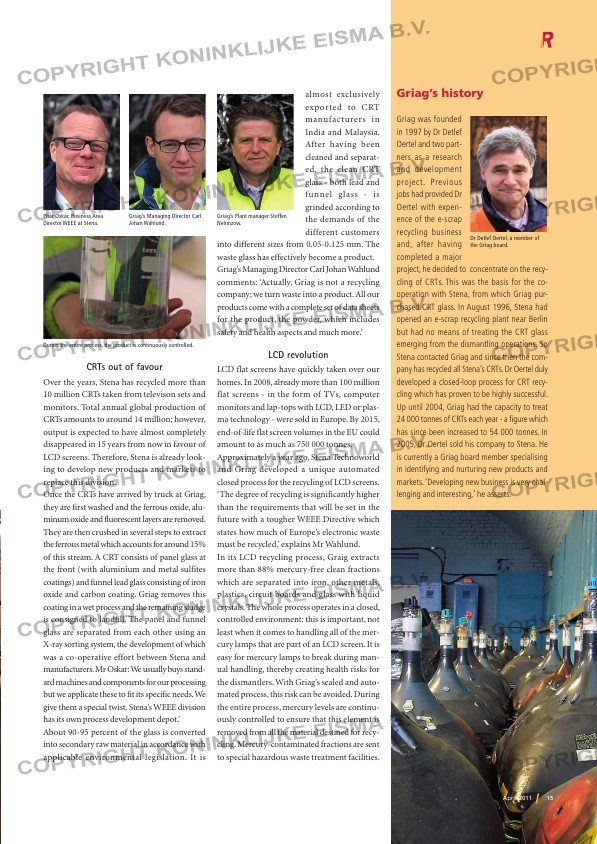Page 15 from: April 2011

15April 2011
CRTs out of favour
Over the years, Stena has recycled more than
10 million CRTs taken from televison sets and
monitors. Total annual global production of
CRTs amounts to around 14 million; however,
output is expected to have almost completely
disappeared in 15 years from now in favour of
LCD screens. Therefore, Stena is already look-
ing to develop new products and markets to
replace this division.
Once the CRTs have arrived by truck at Griag,
they are first washed and the ferrous oxide, alu-
minum oxide and fluorescent layers are removed.
They are then crushed in several steps to extract
the ferrous metal which accounts for around 15%
of this stream. A CRT consists of panel glass at
the front (with aluminium and metal sulfites
coatings) and funnel lead glass consisting of iron
oxide and carbon coating. Griag removes this
coating in a wet process and the remaining sludge
is consigned to landfill. The panel and funnel
glass are separated from each other using an
X-ray sorting system, the development of which
was a co-operative effort between Stena and
manufacturers. Mr Oskar: We usually buys stand-
ard machines and components for our processing
but we applicate these to fit its specific needs. We
give them a special twist. Stena’s WEEE division
has its own process development depot.’
About 90-95 percent of the glass is converted
into secondary raw material in accordance with
applicable environmental legislation. It is
almost exclusively
exported to CRT
manufacturers in
India and Malaysia.
After having been
cleaned and separat-
ed, the clean CRT
glass – both lead and
funnel glass – is
grinded according to
the demands of the
different customers
into different sizes from 0.05-0.125 mm. The
waste glass has effectively become a product.
Griag’s Managing Director Carl Johan Wahlund
comments: ‘Actually, Griag is not a recycling
company; we turn waste into a product. All our
products come with a complete set of data sheets
for the product, the powder, which includes
safety and health aspects and much more.’
LCD revolution
LCD flat screens have quickly taken over our
homes. In 2008, already more than 100 million
flat screens – in the form of TVs, computer
monitors and lap-tops with LCD, LED or plas-
ma technology – were sold in Europe. By 2015,
end-of-life flat screen volumes in the EU could
amount to as much as 750 000 tonnes.
Approximately a year ago, Stena Technoworld
and Griag developed a unique automated
closed process for the recycling of LCD screens.
‘The degree of recycling is significantly higher
than the requirements that will be set in the
future with a tougher WEEE Directive which
states how much of Europe’s electronic waste
must be recycled,’ explains Mr Wahlund.
In its LCD recycling process, Graig extracts
more than 88% mercury-free clean fractions
which are separated into iron, other metals,
plastics, circuit boards and glass with liquid
crystals. The whole process operates in a closed,
controlled environment: this is important, not
least when it comes to handling all of the mer-
cury lamps that are part of an LCD screen. It is
easy for mercury lamps to break during man-
ual handling, thereby creating health risks for
the dismantlers. With Griag’s sealed and auto-
mated process, this risk can be avoided. During
the entire process, mercury levels are continu-
ously controlled to ensure that this element is
removed from all the material destined for recy-
cling. Mercury-contaminated fractions are sent
to special hazardous waste treatment facilities.
Griag’s history
Griag was founded
in 1997 by Dr Detlef
Oertel and two part-
ners as a research
and development
project. Previous
jobs had provided Dr
Oertel with experi-
ence of the e-scrap
recycling business
and, after having
completed a major
project, he decided to concentrate on the recy-
cling of CRTs. This was the basis for the co-
operation with Stena, from which Griag pur-
chased CRT glass. In August 1996, Stena had
opened an e-scrap recycling plant near Berlin
but had no means of treating the CRT glass
emerging from the dismantling operations. So
Stena contacted Griag and since then the com-
pany has recycled all Stena’s CRTs. Dr Oertel duly
developed a closed-loop process for CRT recy-
cling which has proven to be highly successful.
Up until 2004, Griag had the capacity to treat
24 000 tonnes of CRTs each year – a figure which
has since been increased to 54 000 tonnes. In
2005, Dr Oertel sold his company to Stena. He
is currently a Griag board member specialising
in identifying and nurturing new products and
markets. ‘Developing new business is very chal-
lenging and interesting,’ he asserts.
Dr Detlef Oertel, a member of
the Griag board.
Phär Oskàr, Business Area
Director WEEE at Stena.
Griag’s Managing Director Carl
Johan Wahlund.
Griag’s Plant manager Steffen
Nehmzow.
During the entire process, the product is continuously controlled.
014 a 15 05-04-11 0 :1



